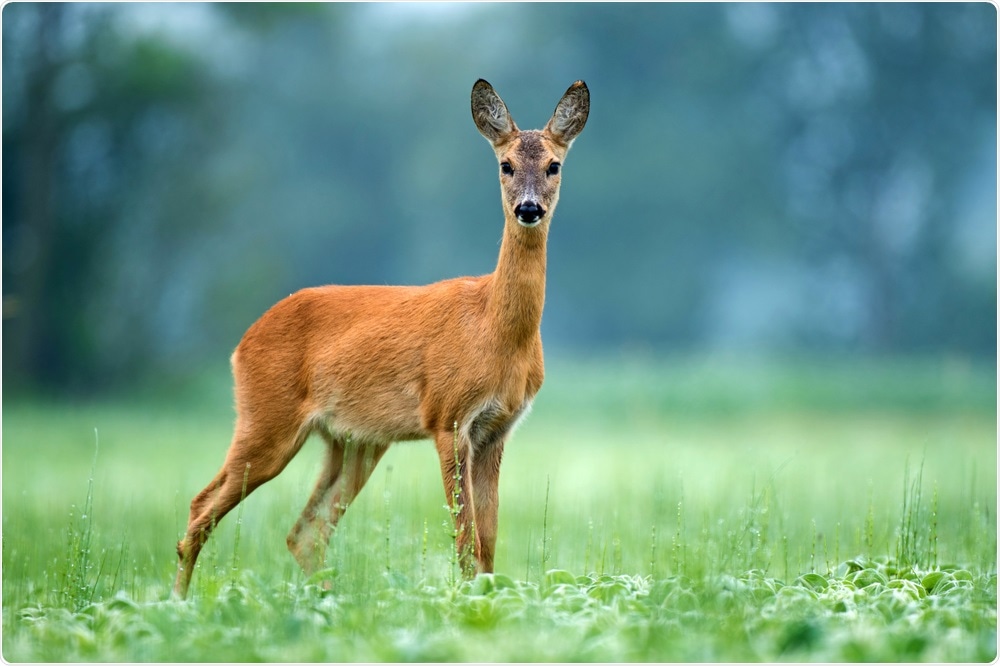New data indicates major animal reservoir of SARS-CoV-2 in deer in Iowa
[ad_1]
Severe Acute Respiratory Syndrome Coronavirus 2 (SARS-CoV-2), which is the virus responsible for coronavirus disease 2019 (COVID-19), is a novel coronavirus of the genus Betacoronavirus that was first identified in Wuhan , in China, towards the end of 2019. SARS-CoV-2 continues to evolve with increasing concern for the emergence of new variants.
So far, transmission of SARS-CoV-2 in free-living non-human animals has not been documented, although they could potentially serve as reservoirs. A new study published on the bioRxiv * The preprint server tests the hypothesis that white-tailed deer (WTD) are susceptible to infection with SARS-CoV-2 and determines whether experimentally infected fawns transmit the virus to other captive deer.
To study: Multiple spillovers and subsequent transmission of SARS-Cov-2 in free-range and captive white-tailed deer (Odocoileus virginianus). Image Credit: Soru Epotok / Shutterstock.com
Background
The widespread transmission of SARS-CoV-2 among humans creates opportunities for spillover effects on non-human hosts such as dogs, cats, zoo animals and farmed mink. This question is of the utmost importance, as an animal’s SARS-CoV-2 infection could make it a reservoir.
It could also lead to the emergence of new variants with a risk of return to humans, such as workers in mink farms. Despite the importance of the subject, the widespread transmission of SARS-CoV-2 in a free animal species has not yet been documented.
A new study
It was recently reported that 40% of white-tailed deer living in the wild in the United States have antibodies against SARS-CoV-2, which was the main motivation for the present study. In addition, there is insufficient evidence for the transmission of SARS-CoV-2 in deer infected experimentally in controlled environments.
Scientists wondered whether infection and subsequent transmission of SARS-CoV-2 from deer occurs in the wild. To answer this question, the researchers in the current study analyzed 283 retropharyngeal lymph node (RPLN) samples from free and captive deer in Iowa from April 2020 to January 2021. The sampling period followed closely. the trajectory of the pandemic in Iowa.
Main conclusions
In the current study, scientists found that one-third of free and captive WTDs had SARS-CoV-2 nucleic acid in their RPLN samples. The positivity rate in deer increased rapidly, with 22 of 77 RPLN samples showing SARS-CoV-2 RNA in November 2020.
In addition, 61 of 75 samples tested positive in December 2020. At the same time, these SARS-CoV-2 infections were peaking in Iowa. Importantly, the results also suggest that many animals had very high viral loads.
The fraction of deer testing positive in the free environment was significantly higher than those in the captive environment. This may be due to the fact that the RPLN collected from deer living in the wild was four times that of captive deer. More research is needed to assess the real reasons for the observed differences in prevalence between free-living and captive deer.
Next, the scientists sequenced the genomes of SARS-CoV-2 present in all of the positive samples. Pangolin version 3.1.11 was used to identify the SARS-CoV-2 lines. The researchers observed that the genomes represented several lines corresponding to viral genotypes circulating simultaneously in humans.
It should be noted that the sampling of humans and deer was not representative; therefore, caution should be exercised in interpreting differences in the apparent prevalence of SARS-CoV-2 lineages between deer and human hosts. Phylogenetic analyzes, coupled with temporal and geographic models of SARS-CoV-2 lineage clustering, provide strong evidence for multiple probable zooanthroponotic outcomes from humans to deer.
Research has shown that experimentally infected deer transmit the virus to other susceptible WTDs between 3 and 5 days after infection; however, deer-to-deer transmission in free-range WTDs has not yet been documented. To this end, scientists applied a molecular epidemiological approach to explore temporal models of recovery of SARS-CoV-2 lines from free-living WTDs. The results supported the circulation of specific lineages among free-living WTDs.
Limits
The selected samples were not spatially representative because the RPLN samples came from a single state in the United States and the sampling was not consistent from county to county. In addition, the results of this study do not speak of the Alpha and Delta variants, as the samples tested dated back to 2020, long before the release of these highly infectious variants. More recent sample testing and robust longitudinal sampling could provide important information on the role of deer as a reservoir of SARS-CoV-2 and / or generator of variants.
Conclusion
A more proactive and robust “One Health†approach to understanding the ecology and evolution of SARS-CoV-2 is needed. It is of paramount importance to study and understand human-animal molecular and ecological interfaces and their relevance for the transmission of infections and diseases. This knowledge will help us predict the next pandemic and control infectious diseases in the years to come.
*Important Notice
bioRxiv publishes preliminary scientific reports which are not peer reviewed and, therefore, should not be considered conclusive, guide clinical practice / health-related behavior, or treated as established information.
[ad_2]

